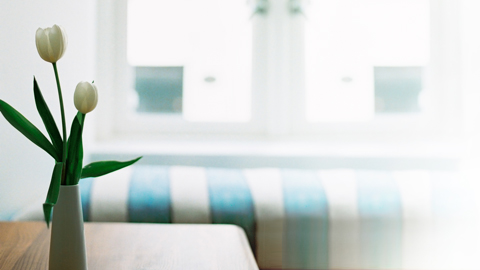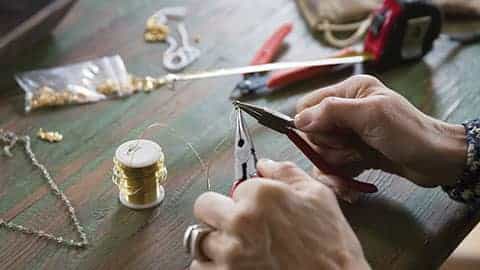Online Interior Design Course
Online Interior Design Course Overview
- Overview
- Unit 1
- Unit 2
- Unit 3
- Unit 4
- Unit 5
- Unit 6
- Reference Library
This online interior design course will prepare you to become a professional interior designer. You will study design trends and history, furniture styles and fabrics, color theory and lighting.
You will complete a series of design projects designed to help you master these skills. Our online interior design class curriculum includes over 13 hours of HD video instruction featuring professional interior designers.
You will learn how to work with interior design clients. From pricing and contracts to purchasing and scheduling, you will learn all the skills required for an interior design career.
Our interior design course is approved by Designer Society of America (DSA). This means students can apply for their RIDQC interior design certification. This industry certification is a powerful addition to any designer's resume.

Additionally, NYIAD students are welcomed as student members of The DSA Student Resource Hub. Through this resource, you can expand your interior design education with exclusive access to tutorials, templates, expert-led webinars, workshops - an invaluable tool for aspiring designers.
DSA / NYIAD students enjoy two years of full access to professional tools, offering a dedicated space to showcase creativity and forge connections with industry professionals, fellow designers, and potential clients.
What You'll Learn in Our Online Interior Design Course
After completing our online Interior Design class, students will be able to:
- Apply skills to design and decorate any interior space like a professional.
- Give examples of design trends, fabrics and furniture styles.
- Explain how to work with clients.
- Outline the processes of pricing and developing and maintaining contracts.
- Review purchasing and scheduling skills.
- Describe color theory and how to work with lighting.
- Discuss the different window and wall treatments available.
- Describe how to give a final presentation of your decoration scheme.
What You Get in the Online Interior Design Course
- 24/7 access to online course materials — prepared by experts in the field
- One-to-one feedback from a professional interior designer — there to help you improve
- Access to a team of advisors — by phone and email to answer all your questions
- 14 days to review the online interior design course risk-free — with a full refund available if you don't love your course
- Discuss courses — get answers to your questions, and share your work in the student forum
- Interior Design Certificate delivered upon graduation
A career in this field may require you to meet certain licensing, training, and other requirements that can vary by vocation and state. You should check with your state, local government and/or licensing board to find out which requirements may be applicable in your state. Click here for contact information on state licensing/regulatory boards and certain professional licensing information.
Unit 1 Nurturing Your Inner Designer
-
Lesson 1.1 Eye of the Designer
In Lesson 1.1: Eye of the Designer, we'll start by going over NYIAD's Three Basic Guidelines for Interior Design. Once you understand these guidelines, we'll start to look at successful rooms in a new way. You'll know what makes an effective design work. Once you know this, you'll be able to apply the same intelligence to your own interior designs.
-
Lesson 1.2 Suitability
In Lesson 1.2: Suitability, we will start to get you thinking about a room's finished picture from the start. From developing a mood and style to staying within a reasonable budget, this lesson will teach you to conceptualize a full design trajectory from the very beginning of any project.
-
Lesson 1.3 Color Basics
In Lesson 1.3: Color Basics, we will begin to explore color theory. We will focus on the basics by introducing you to the color wheel and the primary, secondary and tertiary hues. You will learn how to mix primary hues to produce secondary and intermediate hues, and begin to think about how you will be using color in your design.
-
Lesson 1.4 Planning for People
In Lesson 1.4, Planning for People, we'll start to work on the interactions you'll have with potential clients. You'll learn how to handle yourself professionally when you first meet a client, how to determine what the client wants, the right questions to ask and the best tips for conducting a successful interview.
-
Lesson 1.5 Sketching a Room
In Lesson 1.5, Sketching a Room, you'll start applying fundamental concepts of measurement and planning as you begin to actually create a physical sketch of your first room. From windows and doors to heating and cooling units, we'll walk you through a step by step tutorial as you draft your first real room sketch.
-
Lesson 1.6 Evaluating the Condition of a Room
In Lesson 1.6, Evaluating the Condition of a Room, you will use a room condition checklist to evaluate and document the condition of all relevant room elements. You will calculate measurements, identify doors and windows on a room sketch, and make evaluations for HVAC units as you develop a more natural eye for room evaluations.
Unit 2 Acquiring Skills and Techniques
-
Lesson 2.1 Drawing a Floorplan
In Lesson 2.1: Drawing a Floorplan, you are going to produce a finished floor plan drawn to scale. From there, we'll discuss how this floorplan is used moving forward in the design workflow- from planning furniture to making a formal presentation to your clients.
-
Lesson 2.2 Proportion and Scale
In Lesson 2.2: Proportion and Scale, we'll discuss some of the fundamental concepts of effective interior design from maintaining a harmonic visual weight and balance to combining patterns and colors in an aesthetically pleasing way.
-
Lesson 2.3 Value and Intensity
In Lesson 2.3 Value and Intensity, we are going to be experimenting with changing the pigments of color. We want to introduce you to two ways you can change the appearance of a color without changing its hue. These two ways involve changing either the value of the color or the intensity of the color- or both.
-
Lesson 2.4 Early American Farmhouse Furniture Style
In Lesson 2.4: Early American Farmhouse Furniture Style, we'll help you learn to effectively identify and accurately label different styles of furniture as you become more comfortable with industry terminology and design trends. From there, we'll help you visualize which styles fit in effectively with certain looks so you can plan accordingly in your future designs.
-
Lesson 2.5 How Decorators Charge
In Lesson 2.5: How Decorators Charge, you'll learn the common business and financial dynamics of the interior design industry. You'll understand appropriate amounts to ask clients for compensation, the difference between pre-fixed and hourly structures as well as concepts of cost-effective décor shopping.
-
2.6 Decluttering, Organization, and Storage
In Lesson 2.6: Decluttering, Organization and Storage, we teach you how to design with practicality in such a way to accommodate a client's lifestyle. Whether your client has young children, a physical disability, or any other sort of need, we'll teach you to create a space with a sustainable look they'll easily be able to keep clean and organized.
Unit 3 Working With Furnishings and Fabrics
-
Lesson 3.1 Furniture Layout
In Lesson 3.1: Furniture Layout, we help you establish a simple, easy-to-follow technique to use whenever you design the furniture layout for any room. By the end of the lesson, you'll know the right questions to ask about a design simply by looking at any given floorplan.
-
Lesson 3.2 Form
In Lesson 3.2: Form, we'll discuss the importance of furniture arrangement in terms of relating shape to space in an aesthetically pleasing way. We'll help you understand how to maintain the right balance whenever you place furnishings in a room as well as discuss the impotance form plays in furniture arrangement and interior design as a whole.
-
Lesson 3.3 Color Mood
In Lesson 3.3 Color Mood, we will learn how color selection plays an influential role in the mood of a room. We will look at the initial color selection process and how deciding on a mood you wish to convey in the room beforehand will guide your color choices in designing the room. We will be discussing these factors and how they impact the mood you create.
-
Lesson 3.4 Decorating With Fabrics
In Lesson 3.4: Decorating With Fabrics, we discuss everything you need to know about the process of browsing and selecting the right fabrics. From twill and pile weaves to heat transfer printing, by the end of this lesson you'll have a comprehensive understanding of all textures and styles of interior décor- appropriate fabrics.
-
Lesson 3.5 Mediterranean and French Furniture Styles
In Lesson 3.5: Mediterranean and French Furniture Styles, we discuss and delve deeper into the history and modern application of perhaps the earliest style of furniture still in common use today. From general characteristics to common decorative execution, by the end of this lesson you'll know how to effectively identify and incorporate this style into your future designs with ease.
-
Lesson 3.6 Letters of Agreement
In Lesson 3.6 Letters of Agreement, you'll learn how to write a simple Letter of Agreement that will protect you, be agreeable to your clients and lead naturally to their cheerfully giving you a deposit.
-
Lesson 3.7 Room Redesign
In Lesson 3.7: Room Redesign, we will help guide you through the process of communicating with your clients, analyzing their current space and understanding their goals for the future look. This lesson will provide you with all the helpful tips and techniques needed to redesign your client's home so it looks lively (or tranquil) and inviting again.
Unit 4 Setting the Decorating Stage
-
Lesson 4.1 Planning for Lighting
In Lesson 4.1: Planning for Lighting, we'll look at how to plan for lighting the rooms you're designing. We'll train you to think about what the function of each room is, decide what mood you want to create, and consider how the different lighting types will harmonize in any given room.
-
Lesson 4.2 Balance
In Lesson 4.2: Balance, we talk about concepts of balance. Beginning with a discussion of the difference between formal and informal balance, we'll then move on to explore when an execution of one versus the other is appropriate in a given room, and how to style accordingly.
-
Lesson 4.3 Color Schemes
In Lesson 4.3 Color Schemes, we're ready to select the specific colors to use in our color scheme. Every room you design will be built around a color scheme. The ultimate objective of all your study of color theory is to enable you to use your wonderful sense of color to produce appealing color schemes, and now we start to put this knowledge into practice.
-
Lesson 4.4 Window Treatments
In Lesson 4.4: Window Treatments, we discuss the many ways in which you can decorate a client's windows to add harmonious, supplementary style to any design. From roll-up blinds to shoji screens, we'll explore a number of different stylistic options while learning which settings in which they're best fit.
-
Lesson 4.5 English Furniture Styles
In Lesson 4.5: English Furniture Styles, we look at furniture styles of the 17th century, often referred to in the design world as Jacobean style. By the end of this lesson, you'll know not only how to identify furniture of this style, but when and where it's appropriate to include it in your client's designs.
-
Lesson 4.6 Client-Designer Relationship
In Lesson 4.6 Client-Designer Relationship, we will prepare you to tactfully and professionally handle the most common interactions you'll likely have with interior design clients in the future. From presenting the preliminary budget to helping clients define their taste, this section will help you master effective, polite communication.
Unit 5 Bringing Harmony Into Your Designs
-
Lesson 5.1 Harmony
In Lesson 5.1: Harmony, we take all the pieces of the design puzzle you've gathered thus far throughout the course and combine them to produce a complete, harmonious room.
-
Lesson 5.2 Flooring Treatments
In Lesson 5.2: Flooring Treatments, we teach you the right techniques for choosing appropriate flooring materials to use in any given room. From quarry tiling to oriental rugs, by the end of this lesson you'll have a comprehensive understanding of your flooring treatment options and when and where certain choices are likely a better fit.
-
Lesson 5.3 Wall Treatments
In Lesson 5.3: Wall Treatments, we apply the concepts of function, mood and harmony when making effective, aesthetically pleasing choices of wall décor. We'll learn about numerous options from paint to stone to marble and wood and help you determine when and where certain looks are more appropriate.
-
Lesson 5.4 20th Century Furniture Styles
In Lesson 5.4: 20th Century Furniture Styles, we study the Art Nouveau, Art Deco, Bauhaus and Post-Modernism movements of furniture design as we delve into the popular styles of the 20th century. We'll study the trajectory of their popularity throughout history, then moving on to discuss the effective incorporation of these looks in the present.
-
Lesson 5.5 Vendor Relationships
In Lesson 5.5: Vendor Relationships, we will show you how to work with your vendors to get the best service from them with the least hassle so that you will truly consider them easy to work with on a consistent basis.
-
Lesson 5.6 Accessories
In Lesson 5.6: Accessories, we'll discuss the smaller accessory adjustments you can make to add supplementary style and aesthetic interest to any room. From rustic to romantic, we'll talk about different moods you might try to achieve and then look into methods of choosing and placing accessories accordingly in an effort to do so.
Unit 6 Putting It All Together
-
Lesson 6.1 Finished Presentation
In Lesson 6.1: Finished Presentation, we discuss a number of different ways in which you can handle your finished presentation when revealing your work to your clients. From presenting furniture samples to scheduling meetings at an appropriate frequency, we'll help you master effective communication when working with clients down the road.
-
Lesson 6.2 Kitchens
In Lesson 6.2: Kitchens, we talk about the most effective ways to design a beautiful kitchen without sacrificing functionality and practical comfort. From analyzing traffic patterns to planning sufficient counter space, we'll teach you to design a kitchen with the perfect collaboration of style and function in any home.
-
Lesson 6.3 Baths
In Lesson 6.3: Baths, we discuss the best methods of placing plumbing, fixtures and décor in an effort to build a beautiful bathroom, keeping in mind the ultimate goals of creating open space, connoting luxury and facilitating relaxation.
-
Lesson 6.4 Specialty Rooms
In Lesson 6.4: Specialty Rooms, we discuss those unique places such as home offices, conservatories or wine cellars that can be found in certain homes. By developing a better understanding of their functions and common aesthetics, we'll make sure you're equipped with the design sense to style whatever room a potential client approaches you with- even some of the less common.
-
Lesson 6.5 Opening Your Own Studio
In Lesson 6.5: Opening Your Own Studio, we'll dive into the numerous career options available to graduates of this course. Since most of our interior design students hope to someday launch their own business, we'll discuss the intricacies of this professional process, preparing you to effectively make this move someday if you so choose.
-
Lesson 6.6 Promotion and Sales Techniques
In Lesson 6.6: Promotion and Sales Techniques, we talk about how to succeed as a professional interior designer. From developing a portfolio to creating your first professional website, we'll go over all the intricate details of effective marketing and promotion as we teach you to get your first legitimate business on its feet.
Reference Library
-
When you enroll in NYIAD's Complete Course in Interior Design you have the option to purchase a set of physical materials to go along with your online course.
While we are committed to providing high-quality design courses online, we recognize that many of our students would also like to receive printed lessons that they can keep on their shelves and refer back to anytime they like.
We have created a beautiful set of physical materials, filled with all of the same amazing photographs and expertly prepared course content. They are available for purchase at a cost of $250, which is due upon enrollment.
These materials are not required to complete the course. Without them you will still have access to everything you need online.








